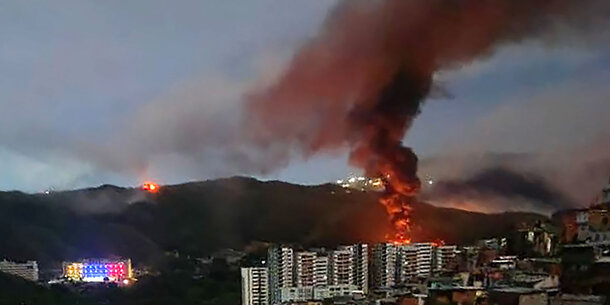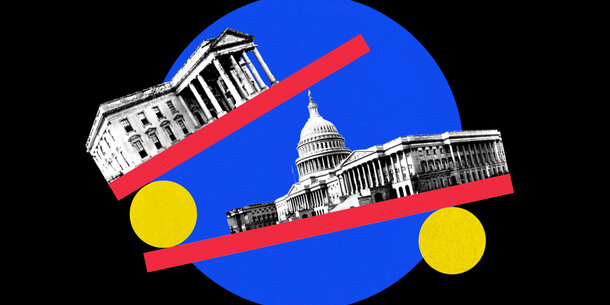This article first appeared in Slate.
In the coming days, Congress will likely pass the annual National Defense Authorization Act, as it does every year. But this year, the legislation could include a provision that is anything but routine: The House version of the bill would transfer command and control of the D.C. National Guard from the president to the district’s mayor. This critical reform—a response to the direct threats to democracy the nation has recently experienced—would both shore up democracy’s safeguards and protect the safety of Washington, D.C.’s residents.
National Guard organizations are the modern incarnation of the colonial state militias; their defining feature is that they generally operate under the command of their state or territorial governor. This is true of all 54 National Guard organizations in the United States today—except one. By law, the D.C. National Guard serves exclusively under the command of the president.
This unique arrangement does not result from any legislative judgment that local control of the district’s Guard forces would be inappropriate. Rather, it is a relic of history. When Congress assigned command of the D.C. Guard to the president, there was no local government for the district—no elected local leader to take charge of its militia. The entirety of D.C. was a federal enclave.
Today, this original justification for presidential control of the D.C. Guard no longer exists. Moreover, the D.C. Guard’s anomalous command structure causes two serious problems, both of which were on display in the last year and a half.
First, it creates a loophole in the Posse Comitatus Act, the law that prohibits the president from using federal military forces to conduct civilian law enforcement without an express statutory exception. This law reflects a core principle of our nation. The founders understood that an army turned inward could easily become an instrument of tyranny for the president.
Because the Posse Comitatus Act applies only to federal military forces, National Guard personnel are not bound by it unless they have been called into federal service, or “federalized.” But even though the D.C. Guard is always under the president’s control, the U.S. Department of Justice has long maintained the legal fiction that it can operate in a non-federal “militia” status. That means the president can use the D.C. Guard as a domestic police force at any time, without invoking the Insurrection Act (which allows the president to use military force to quell violent uprisings or enforce civil rights laws) or any other statutory exception to the Posse Comitatus Act.
In June 2020, Donald Trump took advantage of this loophole, deploying the D.C. Guard—over the objections of D.C.’s mayor—in response to local protests against police brutality. He also asked several governors to deploy their own Guard forces into D.C. Although these out-of-state units were nominally under their governors’ control, they were in fact reporting up through the D.C. Guard’s chain of command, which meant they were ultimately taking orders from the president. In this way, Trump used the Guard’s command structure to completely evade the Posse Comitatus Act, deploying thousands of troops as a domestic police force without any statutory authorization.
The second problem with the D.C. Guard’s command structure came to vivid light on Jan. 6. As rioters breached the U.S. Capitol and threatened the safety of lawmakers and others inside the district, the mayor of Washington, D.C. was not able to deploy D.C.’s own Guard to assist. Instead, she had to ask the D.C. Guard’s Commanding General for help, who then had to request authorization from the Secretary of the Army. This needlessly bureaucratic process took hours—all while D.C. Guard personnel sat waiting on buses. By contrast, Metropolitan Police Department officers arrived on the scene within ten minutes.
The District of Columbia National Guard Home Rule Act, which was incorporated into the House-passed National Defense Authorization Act, solves both of these problems by transferring control over the D.C. Guard from the president to the mayor of Washington, D.C. That would prevent presidents from using the D.C. National Guard to evade the Posse Comitatus Act, bolstering reasonable and long-standing restrictions on presidential power. At the same time, it would enable prompt and predictable local government responses to emergencies.
To be clear, granting the mayor command of the D.C. National Guard is not—for better or for worse—a stepping-stone to D.C. becoming a state. After all, the governors of Puerto Rico, Guam, and the U.S. Virgin Islands all exercise primary control over their National Guard forces, and yet this has not set those territories on the path to statehood. Local control of Guard forces is not, and never has never been, contingent on statehood status.
Nor would the law affect the president’s ability to call the D.C. Guard into federal service, just as he can do with the Guard units of any other territory or state. But those forces would then be bound by the Posse Comitatus Act. Accordingly, the president would have to follow the laws established by Congress and invoke the Insurrection Act before using the D.C. Guard for civilian law enforcement.
This reform has a significant hurdle to clear before it becomes law. Lawmakers are still working to reconcile the House-passed version of the NDAA with the version currently under consideration by the Senate, which does not include such reform. The members involved in these negotiations should recognize the importance of this measure and include it in the final NDAA. If they do that, they will have performed a valuable service for our democracy and for the city in which it sits.




